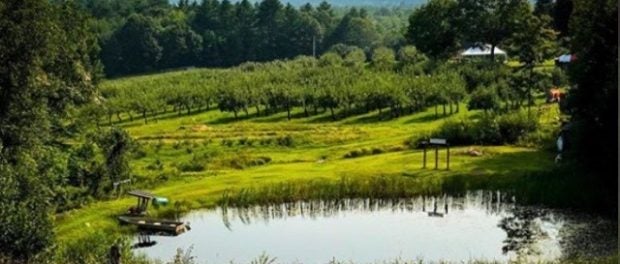The Farm Watering Hole – Finding a Fit

The Farm Watering Hole – The Right Pond in the Right Place for the Right Purpose
Guest post by George Lindemann of Coal Creek Farm
Water is integral to any cattle operation. Whether you are planning on buying a cattle farm or creating a cattle business on an existing farm, understanding and planning water needs is crucial. Each cow can drink as much as 30 gallons of water daily. That’s a lot of water. And in the hot summer months, when there is often less rain, cows need to stay hydrated. Cows need to drink lots of water, but it is also preferable that they drink lots of clean water—that’s right. The science is clear and convincing. Cows perform better and remain healthier when they have access to clean and fresh H2O.
Either city or well water is a safe option. Access to a city tap is ideal in many ways because there is a readily available supply. Automated systems allow the cows to nuzzle a lever and refill a water tub. Or a farmer could manually refill the container a couple of times each day. City tap and wells provide excellent quality and quantity of water, but they are costly. City water in bovine volumes is expensive. Wellwater requires electricity and machinery. Both are potential solutions for emergency backups. At my Cumberland County, TN farm, we mostly use ponds, and always have city water available in case of a bad drought.
If your farm has a creek that runs year-round, cows will enjoy drinking directly from it. Year-round fresh creek water (depending on what’s upstream) might seem ideal, but it’s not. Creek bed degradation is a real environmental concern. Western ranchers with water use permits will pump water out of creeks to avoid damaging the creek environment and clean water supply. When I began farming, I allowed the cows to drink from the smaller streams on my property. I wish I hadn’t. The cows make a mess, and they do indeed dirty the water. We are slowly moving away from this system and toward the farm watering hole.
The Farm Watering Hole
Large ponds that are fed by springs or wet weather run-off are ideal. The right-sized pond can carry enough water to last through the dry season, and rainfall should eventually refill the pond and keep the water clean. If you are lucky enough to have a large adequately supplied pond, think about organizing your fences so that two or more enclosures can use the same water source. It might sound complicated, but it only requires some extra barbed wire and a few more gates. A pond shared by multiple enclosures will need to be maintained more often. During dry August and September months, plan on borrowing or using a backhoe to “dig out” your pond. Even the best-built ponds collect silt over time and need to be maintained.
Finally, always plan as far ahead as possible, knowing that you can alter it as conditions change. When it’s wet in the early spring, make sure the cows live in an enclosure higher up on your property. Rain will hopefully keep refreshing the smaller watering holes, which might run dry or muddy in August. Cows can work their way toward lower-lying areas or enclosures with larger ponds later in the summer when you can’t count on rain to fill a smaller pond. It’s hard to move a heard of cows from one end of the farm to the other. Take time to think through your watering strategy and plan as far as a year ahead. You don’t want August to come around and find out that the cows are high and dry.
-
Other guest posts from George Lindemann include Controlled Burns on the Farm and Using Gravel on Farm Roads.
-
Find tons of other great farming resources here.








 Your Privacy Choices
Your Privacy Choices
Leave a comment